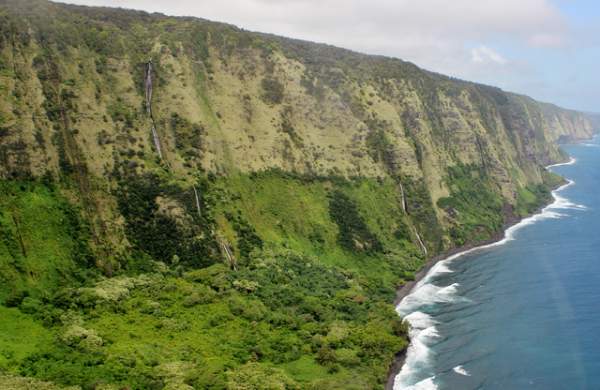A closer look at Kohala Mountain: The Big Island’s oldest above-water volcano
 Between 250,000 and 300,000 years ago, a huge avalanche consumed a slice of Kohala Mountain’s northeast flank more than 12 miles wide at the shoreline. The lasting effects can still be seen today in the sheer cliff walls of the windward Kohala shoreline. Image courtesy of Chelsea Jensen/West Hawaii Today.
Between 250,000 and 300,000 years ago, a huge avalanche consumed a slice of Kohala Mountain’s northeast flank more than 12 miles wide at the shoreline. The lasting effects can still be seen today in the sheer cliff walls of the windward Kohala shoreline. Image courtesy of Chelsea Jensen/West Hawaii Today.There’s little new geologically about the Big Island’s oldest above-water volcano. Its summit — north of Waimea — has been dry land for more than 500,000 years, and it last erupted more than 65,000 years ago. Yet modern scientific findings continue to morph our understanding of the extinct volcano’s past and how it has shaped life on Hawai‘i Island for centuries.
Though Kohala is not as massive as Hawai‘i Island’s other volcanoes, and probably never was, the understanding of the area encompassed by Kohala has changed in the past 20 years. “Kohala is an elongate volcano running northwest by southeast,” said Geology and Geophysics (G&G) volcanology specialist Scott Rowland, who was a part of the comprehensive mapping of Kohala’s lava flows in the mid-1980s. “I think many scientists (who study Hawaiian volcanoes) are coming around to the idea that the Hilo Ridge — north of Hilo and underwater — is probably part of Kohala.”
Between 250,000 and 300,000 years ago, a huge avalanche consumed a slice of the volcano’s northeast flank more than 12 miles wide at the shoreline. The debris spilled more than 80 miles out and onto the ocean floor. The lasting effects can still be seen today in the sheer cliff walls of the windward Kohala shoreline.
Read more about it at West Hawaii Today.


